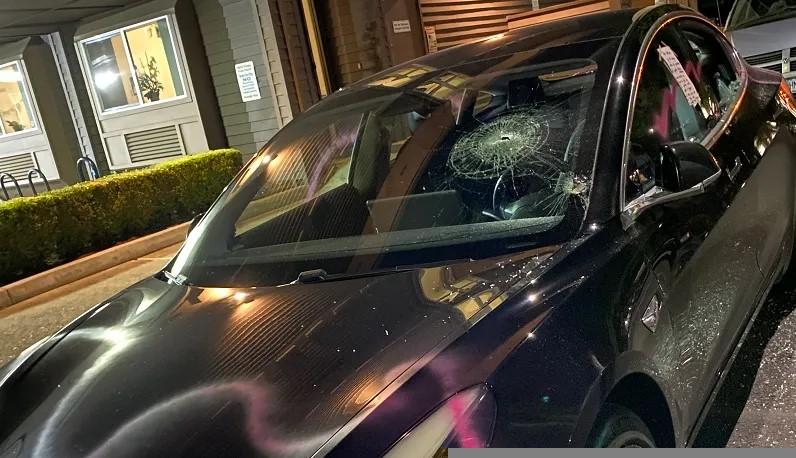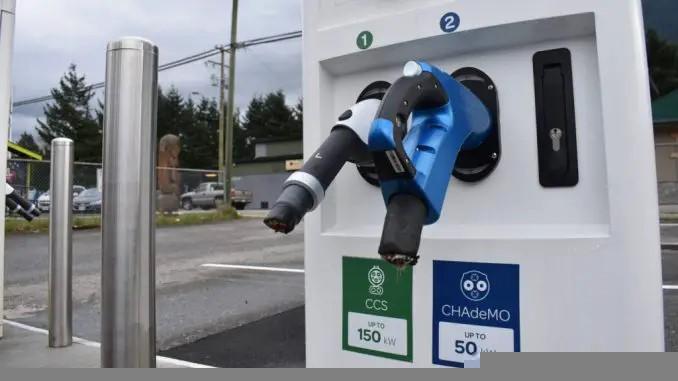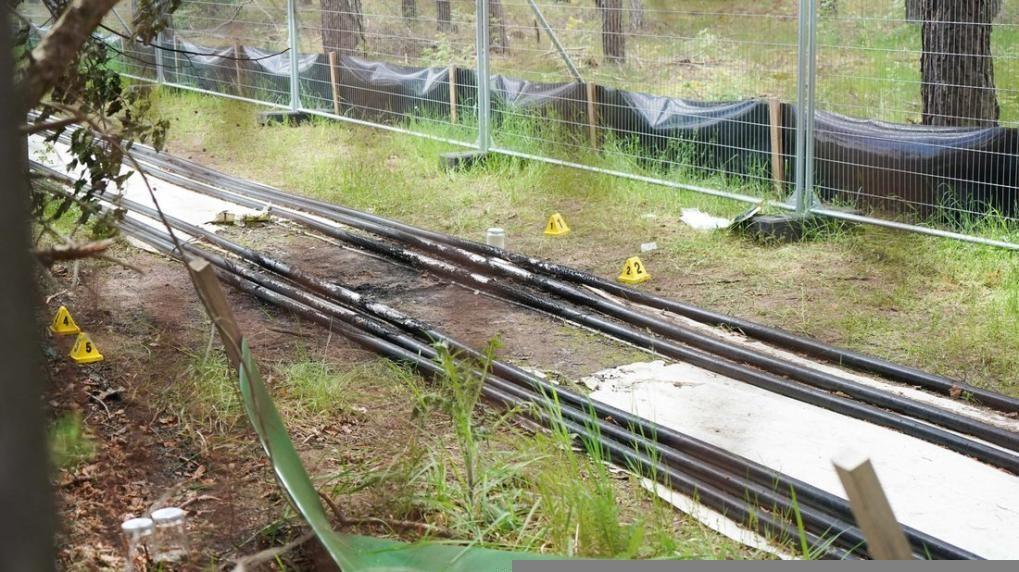

Original text in English
2023
rosecitycounterinfo.noblogs.org
Most expect to be captured on video when walking through downtown streets, which are often littered with traditional types of security cameras, such as the dome cameras, bullet cameras, or the newer remote controlled PTZ (Point, Tilt, Zoom) cameras. Previously, this was less expected in residential neighborhoods, which now have an increasing amount of home surveillance systems like Amazon's Ring or Google Nest cameras. Police departments have seized on the increasing popularity of these devices and struck deals with their parent companies to directly incorporate them into existing surveillance networks and access data without the knowledge or permission of the camera owner. Some doorbell style cameras offer forms of audio surveillance as well: Amazon's Ring cameras, easily spotted by their ominous glowing circle, can reportedly capture conversation-level audio from up to 25 feet away. Ring has partnered with more than a thousand police departments across the United States. Some police departments even ran pilot programs that enabled them to constantly live-stream from residents' doorbell cameras.
While the rapid expansion of home surveillance systems like doorbell cameras has been extensively noted and attacked by anarchists, there has been less focus on the equally rapid expansion of vehicle-based surveillance systems.
For a long time now, cars have been at the center of many high-profile arrests of anarchists. Most major cities have invested in roadside automated license plate readers (ALPR), and many police vehicles are equipped with dashboard ALPR, which read, record, and search every license plate across assorted databases. The No Trace Project has thoroughly documented the many types of trackers and listening devices that police across the world have installed in the vehicles of anarchists. Even without being bugged, almost every modern car contains technology that logs your trips (and much more) and can be easily accessed by law enforcement. In the US, most car manufacturers routinely provide vehicle information to law enforcement without a subpoena or warrant. The vast majority of cars sold in the US over the last few years feature telematic modules that transmit information, including location information, directly to the servers of the manufacturer for remote storage. Further information can be extracted with physical access to the target vehicle: a tool sold by the US company Berla can find the full location history of a vehicle, as well as contact lists, call logs, SMS messages and more of any phone that has been connected to the car's infotainment system.
Cars, especially newer vehicles with built-in computer systems, know everything about their users and, consequentially, the people around them. Tesla is taking this a step further, turning cars into mobile, high-definition video surveillance systems.
Every Tesla vehicle has cameras that provide 360-degree video surveillance around the vehicle while it is in motion. There are nine cameras in total: eight exterior facing cameras (three front-facing cameras, two fender cameras, one rear-view camera, and two side cameras on the “b-pillar” between the windows) and one interior facing cabin camera. The footage that is collected by these cameras is stored locally on a USB drive or other storage device connected to the vehicle's central computer system, but footage also makes its way to Tesla's servers. For instance, Tesla offers a (minimum) 72-hour backup of all footage recorded in case the driver-installed USB drive is stolen. Some countries have banned Teslas from driving near sensitive government areas, such as China and Germany, which banned the cars from driving on certain Berlin police grounds.
All nine Tesla cameras are actively recording while the car is moving. However, even when the car is parked and turned off, the cameras are often still recording. Tesla offers a feature called “sentry mode” which transforms the parked car into a camera system that can capture video from all directions. This mode supposedly has to be manually switched on by the owner. It uses four of the nine cameras (one on each side of the vehicle), and the video feed can be accessed in real-time via a smartphone app. The cameras are activated and an “alert” notification is sent to the app every time someone touches the vehicle or the vehicle moves, but also activate when someone walks near the vehicle or other nearby movement is detected. Videos are uploaded to centralized Tesla servers as a backup. Even if the cameras did not activate or trigger a “sentry event,” video can still be recovered of anything that happened in camera range within (at least) an hour before it is overwritten. However, Tesla owners can use publicly available code to modify their computer system and store all footage indefinitely.

A Tesla damaged during a demo in Portland, Oregon in June 2022.
The cameras used in Teslas are made by the technology and weapons giant Samsung. So far, most have a resolution of 1.2 megapixels, but since 2023 some cars have 5 megapixel cameras which are significantly more detailed and color-accurate. The front cameras have a range of up to 250 meters. It is possible for older models of Teslas to be upgraded to the newer hardware and better cameras.
It is already possible to harness the video footage from Teslas and run it through artificial intelligence (AI) programs that automatically process faces and license plates. In 2019, a presenter at a security conference showed how he could use his Tesla, a relatively affordable minicomputer, and publicly available programs to create a system to track and store all passing faces and license plates. Combining high quality security cameras that capture footage with artificial intelligence powered programs that automatically analyze that footage is not a thing of the future, it is already here. Google's home security system, Google Nest, comes equipped with a feature that automatically keeps track of “familiar faces,” and many other consumer-grade security systems have similar features. Soon, the rent-a-cop watching dozens of TV screens from a windowless room could be augmented, or even replaced, by AI-powered security systems that are taught to automatically flag certain faces and “suspicious” behaviors and alert security. The recent development of 5G networks enables the wireless connectivity and high-speed data transfer needed to transmit sufficiently detailed live video from security cameras to AI systems in data centers and law enforcement fusion centers.
Just as doorbell cameras have become a major resource to police, Tesla cameras have already proved to be an important and increasingly sought-after source of evidence in investigations. Footage from Teslas, including parked Teslas in sentry mode (which was only introduced by the company in 2019), has already appeared in a number of cases in the US and beyond:
- 2019 in Berkeley, CA: Video from a Tesla allows police to identify and arrest someone for breaking into a car. They were wearing a GPS-tracking ankle monitor at the time of the break-in.
- 2019 in San Fransisco, CA: A Tesla is broken into and its cameras capture the face and license plate of the suspect, resulting in arrest.
- 2020 in Springfield, MA: FBI investigation into a racist Church arson and other crimes involves footage from a parked Tesla, which clearly shows the face of the suspect as he steals one of the wheels from it.
- 2020 in Stamford, CT: Two were arrested for armed robbery after police take footage from a parked Tesla that shows the license plate of their getaway car.
- 2021 in Berlin, Germany: An explosive device is placed and activated near a construction site. Berlin police used video from a nearby parked Tesla to identify and arrest an allegedly “left-extremist” suspect.
- 2021 in Memphis, TN: A parked Tesla records people stealing the wheel of a nearby car, and the footage is publicized by police in an attempt to identify the suspects.
- 2021 in UK: Police use video from Tesla to find and arrest a person who keyed the parked car. Video showed the face and license plate of the suspect.
- 2021 in Riverside, CA: Tesla driving on highway had its window shot out by a BB gun, police used the footage to identify the suspect's car and make an arrest.
- 2023 in San Jose, CA: PG&E transformer boxes were blown up in two separate attacks, knocking out power to thousands. A multi-agency investigation results in an arrest, a key piece of evidence is video from a parked Tesla that shows the suspect near the scene. Phone data (likely a geo-fence warrant) is also used to identify and arrest a suspect.
- 2023 in Bend, OR: Police investigating a murder case make a public plea for Tesla owners to check their footage from the day and look for a specific car.
In these cases and others, law enforcement made direct quotes about the importance of Tesla videos in the course of the investigation:
Without people being willing to share their surveillance videos with us, we probably wouldn't have been able to make progress on this case, so that was essential.
— Assistant Police Chief of San Jose, CA
This is the one that did him in and this is the reason why he got arrested.
— Police officer pointing to a Tesla camera
It's rare but we're seeing more and more of these [Tesla] surveillance cameras all over the place now and we're happy to see that because it's a really effective crime-fighting tool.
— San Fransisco PD PIO
Today's technology enables automobile manufacturers like Tesla to generate recordings, which of course have enormous added value for the police when solving crimes and traffic accident scenarios. It would be negligent not to use this opportunity.
— President of the Gewerkschaft der Polizei, a German police union
As more Teslas hit the road, the state's surveillance network expands; the supposed line between “citizen” and “cop” vanishes. The same surveillance technology that Tesla has pioneered is being introduced by other car manufacturers and after-market manufacturers. A new feature by BMW allows users to generate a live 3D render of their car's surroundings from a smartphone app. Other companies are not far behind, teasing features that are similar to Tesla's sentry mode.

Electric vehicle charging station with severed cables.
What should anarchists take away from this? How can we continue to attack this panoptic hellscape and get away with it?
When concerned about potential video surveillance, we must now remember to check for Tesla vehicles in addition to doorbell cameras and more traditional visible security systems. It may be possible to avoid activating the cameras of parked Teslas by walking on the other side of the street. Unlike all other forms of surveillance cameras, parked cars will not always be in the same spot — a street free of any visible cameras one night might have a Tesla parked on it the next. This means car cameras present a particular challenge when planning paths to avoid surveillance. For now, no other major car manufacturer seems to regularly include surveillance cameras, so Tesla's unique shape allows them to be identified at a distance and avoided (or targeted!) more easily.
Unfortunately, it is often impossible to avoid the eyes of cameras completely. General practices for avoiding identification through security camera footage include: using loose-fitting clothing to cover up completely. If circumstances prevent covering the eyes with sunglasses or otherwise, ensure that everything surrounding the eyes remains hidden. Eyebrows in particular have a tendency to reveal themselves in the eye gap of a mask and can be very identifying. The clothes used, including shoes, should only be worn once, and should be acquired in a way that cannot be traced (by store cameras, transaction history, etc.) Ideally, the clothes lack logos or unique patterns. Clothes should be discarded or destroyed immediately after, again through untraceable methods and in a location with no connection to you. Gait analysis, the forensic method of identifying your unique walking patterns, may become increasingly enabled by artificial intelligence; consider modifying how you walk when on camera. Video footage showing patterns of left-handedness has also been used by investigators to identify suspects.
It is best to keep as much distance from cameras as possible and avoid turning directly towards them. Simply turning your head away from the vehicle while you walk by can help conceal your face. Even when wearing a mask, higher definition footage can still reveal identifying features. Tesla cameras differ from most traditional security cameras in that they are below head height rather than overhead. Umbrellas and the brims of hats and hoods that might offer effective concealment from an overhead camera may be ineffective against the low angles of a car camera.
In most of the arrests involving Tesla footage, the person was identified by their car, and often a license plate. The existence of ALPR, other cameras, and centralized databases makes it very difficult, and often impossible, to travel by car without leaving a trail. In contrast, bicycles lack license plates, are much more easily checked for tracking devices, are simple to steal or buy for little cash and discard, and have proven to be significantly more difficult to trace in criminal investigations.
In attacks against Teslas or things nearby, be aware that you are on camera and prepare accordingly. With some practice, slingshots (or other projectiles) can be used effectively from a distance. An awl can easily deflate tires by stabbing into the upper sidewall, and is quieter than a knife, though the damage is easier to patch. It is not too hard to spot the Tesla cameras once you familiarize yourself with their locations, and they can be easily covered with spray paint.
Some of the usual suggested methods for incendiary attacks against cars become obsolete or ill-suited when we begin to consider electric vehicles. Advice on placement of an incendiary device often assumes the existence of a gas tank and a flammable fuel engine. With electric vehicles, and Teslas in particular, the major flammable parts of the car are the tires and the lithium-ion battery, which is throughout most of the bottom of the car in the chassis. Tires catch fire more easily, and some chemical fire-starter cubes or road flares heating the tire directly can be sufficient. The flaming tire may then set fire to the batteries.To target the batteries, the underside of the car must be heated enough to create a thermal runaway effect in the battery cells. This can be very difficult to extinguish and almost guarantees the total destruction of the car. Gasoline or a similar accelerant concentrated in one spot under the car is the most effective way to quickly generate enough heat for a battery fire. It is inadvisable to break car windows to place an incendiary device inside, which increases risk of discovery (breaking glass is loud!) and DNA traces.

From a responsibility claim for an arson in Frankfurt, Germany in 2023: “We torched some new Teslas in Frankfurt tonight. As a salute to the protests in Munich. As one attack among many on the destructive auto industry… Tesla is one of our most prominent enemies. The company represents like no other the ideology of green capitalism and the ongoing global and colonial destruction.”
The “electric car revolution” continues to pillage the earth through resource extraction, cars continue to kill and maim human and non-human animals in massive numbers, and systems of surveillance and control continue to be refined and expanded. Tesla, along with other electric vehicle manufacturers, can and should be attacked by anarchists. It can be attacked at many levels: the network of charging stations is vulnerable to sabotage, the vehicle lots and buildings can be attacked, and the cars themselves can be easily damaged or destroyed.

Six high-voltage cables supplying power to the site of a Tesla “gigafactory” were torched near Berlin, Germany in May 2021. Translated from the communique: “Our fire opposes the lie of the ecological car”.
Fuck Tesla. Fuck all cars and all cameras. Death to the state. Nothing but love to all anarchist troublemakers, vandals, and creatures of the night. Strike wisely and don't get caught!
Further reading and resources for the daring:
- A recipe for nocturnal direct actions
- Fashion tips for the brave
- Minimizing DNA traces during riotous moments
- The simplest way to burn a vehicle
- Warrior Up (some guides on this website are not be up to date with modern investigatory tactics, or include unreliable methods)
Some of these links contain detailed guides for destructive actions. It is best to view these using Tails or Whonix. A setup guide and download link for Tails can be found here.

 Ελληνικά
Ελληνικά